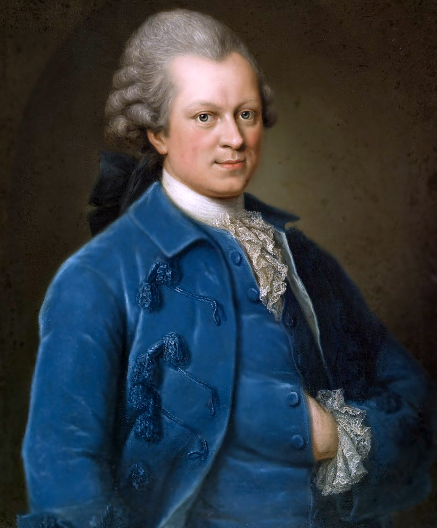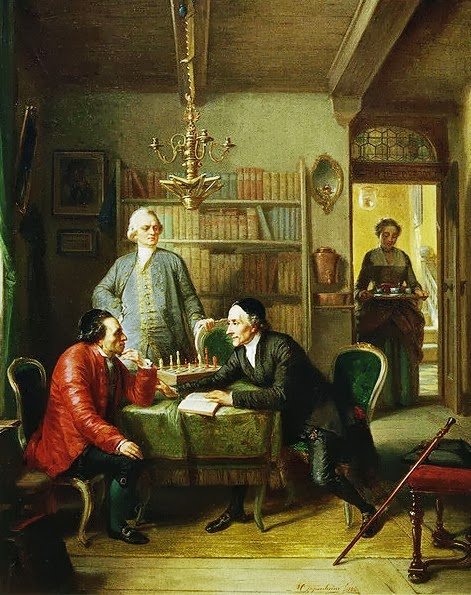
Gotthold Ephraim Lessing (1721 – 1789) Painting by Anna Rosina de Gasc (Lisiewska), 1767/1768, Gleimhaus Halberstadt
On January 22, 1708, German author of the enlightenment Gotthold Ephraim Lessing was born. With his dramas and his theoretical writings, which are above all committed to the idea of tolerance, this enlightener showed the further development of the theater a significant path and had a lasting influence on the public impact of literature. Lessing is the first German dramatist whose work is still being performed in theaters without interruption.
“The true value of a man is not determined by his possession, supposed or real, of Truth, but rather by his sincere exertion to get to the Truth. “
– Gotthold Ephraim Lessing, Anti-Goetze (1778)
Gotthold Ephraim Lessing – Youth and Education
Gotthold Ephraim Lessing was born in Kamenz, Margraviate of Upper Lusatia, as the third child and second oldest son of Johann Gottfried Lessing, archdeacon of Kamenz, and his wife Justina Salome (née Feller). Lessing’s father initially taught his son himself to prepare him for school and university. At the age of five, Lessing was already able to read the Bible and the catechism formulated by his father. He was then assigned a private tutor, Christlob Mylius, at his side. In 1737, when the instruction at the public Latin school was no longer sufficient for the student’s intellectual abilities, Lessing’s father submitted a request to the Elector to admit his son Gotthold Ephraim as an “alumnus with a free boarding position” at the princely school of St. Afra in Meissen. In 1741 endowed with a scholarship he attended Meissen and the school’s extensive curriculum in the ancient languages Latin, Greek, and Hebrew. Lessing’s first attempts at writing date back to this time.
In 1746, Lessing went to study at the University of Leipzig, where he initially studied theology according to his father’s wishes, but soon lost interest in it and, under the influence of his friend Mylius, began to take up poetry and theater, to the chagrin of his parents. In 1748 he switched to the study of medicine and the same year went to the University of Wittenberg for further studies. In 1748, after surviving an illness, he moved to the Brandenburg royal seat of Berlin. There he reviewed the Berlinerische Privilegierte Zeitung (later the Vossische Zeitung), became a contributor to the Critische Nachrichten aus dem Reiche der Gelehrsamkeit in 1750, and met Voltaire, among others, in 1750.[1] From 1751 Lessing continued to concentrate on his studies in Wittenberg, where he received his Magister Artium degree on April 29, 1752, probably with a thesis on the Spanish physician and philosopher Juan Huarte.
Meeting Moses Mendelssohn
“It is infinitely difficult to know when and where one should stop, and for all but one in thousands the goal of their thinking is the point at which they have become tired of thinking.”
– Gotthold Ephraim Lessing, Letter to Moses Mendelssohn, January 9, 1771
When Lessing returned to Berlin in November 1752, he met, among others, the philosopher Moses Mendelssohn,[2] with whom he had a long-standing friendship. In October 1755, he returned to Leipzig. In the following year, he planned an educational journey through the Netherlands, England and France, which was to last several years, as the companion of the Leipzig merchant’s son Christian Gottfried Winkler (1731-1795). However, he and Winkler in particular had to break off their journey in Amsterdam because of the Seven Years’ War. In 1758 Lessing moved again to Berlin, where he published together with Friedrich Nicolai and Moses Mendelssohn Briefe, die neueste Literatur betreffend (Letters concerning the newest Literature). In 1760 Lessing was elected an external member of the Berlin Academy of Sciences.

Lessing and Lavater as guests in the home of Moses Mendelssohn. Painting by Moritz Oppenheim (1856)
From 1760 to 1765 he was employed in Breslau as a secretary to General Tauentzien. In 1765 he returned to Berlin. In 1767 Lessing went to the Hamburg National Theater for three years as a dramaturge and advisor. In Wolfenbüttel, he became librarian at the Herzog August Bibliothek in 1770. In 1771 he became engaged to Eva König, who had been widowed in 1769. In 1775, his work in the library was interrupted by several trips to Eva König’s respective places of residence, to Vienna via Leipzig, Berlin, Dresden and Prague, and an audience with Emperor Joseph II. As a companion of the Brunswick Prince Leopold, he traveled to Italy with stays in Milan, Venice, Florence, Genoa, Turin, Rome, Naples and Corsica.
Later Life and Death
On October 8, 1776, he and Eva König were married in Jork near Hamburg in the home of Johannes Schuback. On Christmas Eve 1777, she gave birth to their son Traugott, but he died the following day. On January 10, 1778, Eva Lessing also died of childbed fever. In 1779, Lessing’s health deteriorated. At the end of January 1781, the poet, plagued by asthma attacks, contracted a cold while traveling from Wolfenbüttel to Brunswick in freezing temperatures. On February 3, he suffered a collapse in the apartment of his host, assistant and confidant Simson Alexander David. On February 15, 1781 in the evening between eight and nine o’clock Lessing died in the arms of Simson Alexander David immediately after a bloodletting from dropsy of the chest in the house of the Brunswick wine merchant Angott, where the poet kept an apartment. Until his last breath, Lessing is said to have been animatedly excited about current church politics.
Lessing as Philosopher of the Age of Enlightenment
“What is a hero without love for mankind?”
– Gotthold Ephraim Lessing, Philotas (1759)
In his writings on the philosophy of religion, Lessing argued against belief in revelation and against adherence to the “letter” of the Bible by the prevailing doctrine. In contrast, he trusted in a “Christianity of reason” that was oriented toward the spirit of religion. He believed that human reason, prompted by criticism and contradiction, would develop even without the help of a divine revelation. In order to stimulate a public discussion against the orthodox “Buchstabenhörigkeit,” he published seven Fragmente eines Ungenannten (fragments by an unnamed person) between 1774 and 1778, which led to the so-called Fragment Controversy. In addition, in the numerous disputes with the representatives of the prevailing doctrine, he advocated tolerance toward the other world religions. In the final leg of his life, Lessing threw himself into an intense evaluation of theology and religion. He did much of his studying by reading manuscripts he found while working as a librarian.
He also implemented this attitude dramatically in the drama Nathan the Wise, when he was banned from further theoretical publications. In the writing Die Erziehung des Menschengeschlechts (The Education of the Human Race), he presented his position in a coherent way. Inspired by Jean de La Fontaine,[4] he also devoted himself to the animal fable, which he, however, reconceived in an enlightened and metaphysical way: for example, in his fable Der Rabe und der Fuchs (The Raven and the Fox), flattery is not rewarded, as in the original form of the story, but severely punished with the aim of achieving a more just morality.
Lessing’s Theatre Theories
In his theoretical and critical writings on theater and his own dramatic works, he tried to contribute to the development of a new bourgeois theater in Germany. In his tragedy-poetical writings (Briefwechsel über das Trauerspiel, Hamburgische Dramaturgie), he argued for a return to the classical principles of Aristotle’s Poetics, but modified the Aristotelian doctrine of the tragic affects of pity and fear (eleos and phobos) by declaring pity the decisive tragic affect. His own works seem to us today like the prototypes for the later developing bourgeois German drama. Miss Sara Sampson is regarded as the first German-language bourgeois tragedy, Minna von Barnhelm as the model for many classical German comedy plays, Nathan der Weise (Nathan the Wise) as the first ideological drama. His theoretical writings Laocoon: An Essay on the Limits of Painting and Poetry and Hamburgische Dramaturgie set standards for the discussion of aesthetic and literary-theoretical principles. In his search for a German-language bourgeois theater, Lessing was strongly influenced intellectually by the French encyclopedist and philosopher Denis Diderot.[3]
Legacy
Lessing was a versatile poet, thinker and critic. As a leading representative of the German Enlightenment, he became a mastermind for the new self-confidence of the middle classes. His theoretical and critical writings are characterized by an often witty-ironic style and unerring polemics. The stylistic device of dialogue suited his intention of always looking at a matter from several sides and also searching for traces of truth in the arguments of his opponent. This never appeared to him as something fixed that could be possessed, but always as a process of coming closer. The idea of freedom – for theater from the dominance of the French model, for religion from the dogma of the church – runs like a thread through his entire life. Consequently, he also advocated the liberation of the aspiring bourgeoisie from the paternalism of the nobility.
Richard Velkley, The Tyranny of Beauty: On Art and Truth in Lessing’s Laocoon, [12]
References and Further Reading:
- [1] Voltaire – Libertarian and Philosopher, SciHi Blog
- [2] Moses Mendelssohn and the Jewish Enlightenment, SciHi Blog
- [3] Denis Diderot’s Encyclopedia, or a Systematic Dictionary of the Sciences, Arts, and Crafts, SciHi Blog
- [4] Jean de La Fontaine and the Moral of the Story, SciHi Blog
- [5] Works by or about Gotthold Ephraim Lessing at Internet Archive
- [6] “Works by Gotthold Ephraim Lessing”. Zeno.org (in German)
- [7] “The Tyranny of Beauty: On Art and Truth in Lessing’s Laocoon” by Richard Velkley, Meem Library @youtube
- [8] Wilfried Barner: Lessing, Gotthold Ephraim. In: Neue Deutsche Biographie (NDB). Band 14, Duncker & Humblot, Berlin 1985
- [9] Works of Gotthold Ephraim Lessing at Deutsche Digitale Bibliothek
- [10] Werke von Gotthold Ephraim Lessing im Projekt Gutenberg-DE
- [11] Gotthold Ephraim Lessing at Wikidata
- [12] Richard Velkley, The Tyranny of Beauty: On Art and Truth in Lessing’s Laocoon, Meem Library @ youtube
- [13] Timeline for Gotthold Ephraim Lessing, via Wikidata





